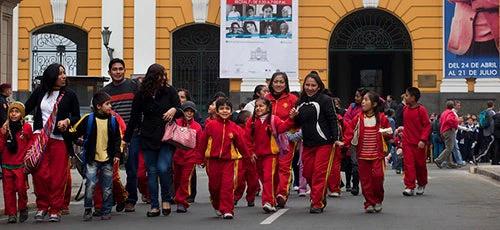
“I want my children to be able to go to school. I don't want them to suffer like me.” Little by little this dream disappears as a piece of sugar, as water that runs through your hands. The long lists of material, a simple button that is missing on a shirt, this can be the end of a dream for learning to read and write.
This short text from Peru published on the International Day for the Eradication of Poverty website illustrates how the very poor struggle every day. An empty stomach, a lack of clothes, a gap in learning may all lead children in poverty to miss school and ultimately drop out. Keeping the dreams of these children and their parents alive is in essence the message of the International Day for the Eradication of Poverty. Every year on October 17, communities around the world gather to pay honor to the struggles of the extreme poor to emerge from poverty.
The celebration of the day dates back to Joseph Wresinski, a Catholic priest who founded the International Movement ATD Fourth World. On October 17, 1987, Wresinski and his organization gathered 100,000 people in Paris, France to honor the victims of extreme poverty, violence and hunger. They unveiled a commemorative stone that proclaims: “Wherever men and women are condemned to live in extreme poverty, human rights are violated. To come together to ensure that these rights be respected is our solemn duty.” The stone has been replicated in other countries including Burkina Faso, Canada, Germany, Philippines, Portugal Reunion Island, Switzerland, and the US. The international day was recognized by the United Nations in 1993.
Why did Wresinski make a link between extreme poverty and human rights? Wresinski’s understanding of the plight of the extreme poor emerged from his life experience (he was born poor) and 40 years of grass-roots involvement with families in extreme poverty in both developing and developed countries. Instead of defining extreme poverty solely in monetary terms, he used the following definition in a report for the French Economic and Social Council:
“A lack of basic security is the absence of one or more factors that enable individuals and families to assume basic responsibilities and to enjoy fundamental rights. Such a situation may become more extended and lead to more serious and permanent consequences. Extreme poverty results when the lack of basic security simultaneously affects several aspects of people's lives, when it is prolonged, and when it severely compromises people's chances of regaining their rights and of reassuming their responsibilities in the foreseeable future.”
This definition has been adopted in several United Nations reports. It is very different from the consumption-based ($1.25 a day) definition used by the World Bank (for a first-rate analysis of extreme poverty so defined, see the report released last week by Dean Jolliffe, Peter Lanjouw and colleagues). The Bank’s definition of extreme poverty makes sense for practical measurement purposes at a global level. But as a definition it does not necessarily provide much insight into what goes on in the life of the extreme poor. Wresinki’s approach tried to do that. It relies on three main ideas.
First, according to Wresinski, extreme poverty results from a lack of basic securities – not only a lack of income, but also the lack of education, employment, housing, health care, and civil and political rights. Beyond some threshold, the insecurity endured by the poor is such that the lack of multiple basic securities leads to extreme deprivation. The extreme poor then become prisoners of a vicious circle. With no security left as a solid foundation to rely upon, they cannot emerge from extreme poverty by themselves.
Second, the extreme poor often share a long history of deprivation, and as a result, from exclusion and isolation. The longer a person experiences extreme poverty, the more socially excluded he/she may become.
Third, for each human right, the link between the exercise of that right – for example, raising one’s children, and the corresponding responsibility – in that case being able to provide for one’s children, may be broken for the very poor. The very poor often say that what is hardest in their life is precisely the difficulties they face in being good parents and neighbors. Wresinski further argued that the life of the extreme poor is a prime example of the indivisibility of human rights.
Wresinski’s approach to extreme poverty was based on the reality of everyday life for the extreme poor. His approach is complex, but rich in insights. Because the extreme poor suffer from multiple disadvantages, multi-sectoral integrated policies are required to help them succeed in their own efforts to emerge from poverty.
The theme of the International Day for the Eradication of Poverty this year is: “Leave No One Behind: Think, Decide and Act Together against Extreme Poverty.” Wresinski was convinced that the extreme poor know best what is required to fight poverty, and that we should learn from them. They can indeed teach us a few things about life and resilience.
Follow the World Bank education team on Twitter at @WBG_Education
Related
- International Day for the Eradication of Poverty
- Bank seminar proceedings on the work of Wresinski’s organization
- Report: Chronic Poverty and Lack of Basic Security: The Wresinski Report of the Economic Social council of France
- Report: A Measured Approach to Ending Poverty and Boosting Shared Prosperity


Join the Conversation